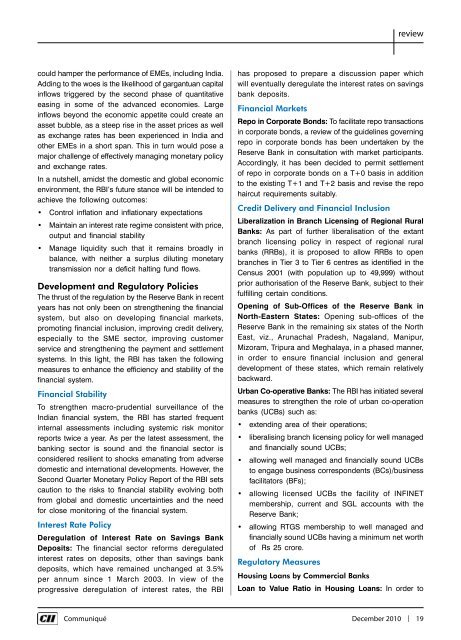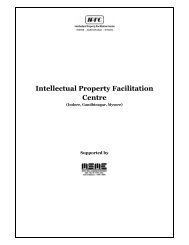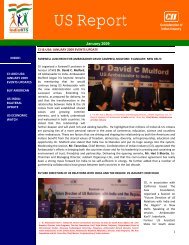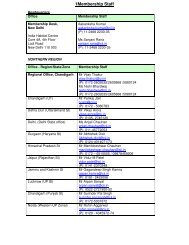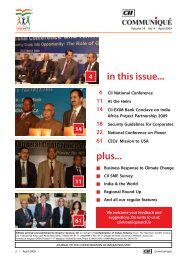CII Communique - December, 2010
CII Communique - December, 2010
CII Communique - December, 2010
Create successful ePaper yourself
Turn your PDF publications into a flip-book with our unique Google optimized e-Paper software.
eview<br />
could hamper the performance of EMEs, including India.<br />
Adding to the woes is the likelihood of gargantuan capital<br />
inflows triggered by the second phase of quantitative<br />
easing in some of the advanced economies. Large<br />
inflows beyond the economic appetite could create an<br />
asset bubble, as a steep rise in the asset prices as well<br />
as exchange rates has been experienced in India and<br />
other EMEs in a short span. This in turn would pose a<br />
major challenge of effectively managing monetary policy<br />
and exchange rates.<br />
In a nutshell, amidst the domestic and global economic<br />
environment, the RBI’s future stance will be intended to<br />
achieve the following outcomes:<br />
• Control inflation and inflationary expectations<br />
• Maintain an interest rate regime consistent with price,<br />
output and financial stability<br />
• Manage liquidity such that it remains broadly in<br />
balance, with neither a surplus diluting monetary<br />
transmission nor a deficit halting fund flows.<br />
Development and Regulatory Policies<br />
The thrust of the regulation by the Reserve Bank in recent<br />
years has not only been on strengthening the financial<br />
system, but also on developing financial markets,<br />
promoting financial inclusion, improving credit delivery,<br />
especially to the SME sector, improving customer<br />
service and strengthening the payment and settlement<br />
systems. In this light, the RBI has taken the following<br />
measures to enhance the efficiency and stability of the<br />
financial system.<br />
Financial Stability<br />
To strengthen macro-prudential surveillance of the<br />
Indian financial system, the RBI has started frequent<br />
internal assessments including systemic risk monitor<br />
reports twice a year. As per the latest assessment, the<br />
banking sector is sound and the financial sector is<br />
considered resilient to shocks emanating from adverse<br />
domestic and international developments. However, the<br />
Second Quarter Monetary Policy Report of the RBI sets<br />
caution to the risks to financial stability evolving both<br />
from global and domestic uncertainties and the need<br />
for close monitoring of the financial system.<br />
Interest Rate Policy<br />
Deregulation of Interest Rate on Savings Bank<br />
Deposits: The financial sector reforms deregulated<br />
interest rates on deposits, other than savings bank<br />
deposits, which have remained unchanged at 3.5%<br />
per annum since 1 March 2003. In view of the<br />
progressive deregulation of interest rates, the RBI<br />
has proposed to prepare a discussion paper which<br />
will eventually deregulate the interest rates on savings<br />
bank deposits.<br />
Financial Markets<br />
Repo in Corporate Bonds: To facilitate repo transactions<br />
in corporate bonds, a review of the guidelines governing<br />
repo in corporate bonds has been undertaken by the<br />
Reserve Bank in consultation with market participants.<br />
Accordingly, it has been decided to permit settlement<br />
of repo in corporate bonds on a T+0 basis in addition<br />
to the existing T+1 and T+2 basis and revise the repo<br />
haircut requirements suitably.<br />
Credit Delivery and Financial Inclusion<br />
Liberalization in Branch Licensing of Regional Rural<br />
Banks: As part of further liberalisation of the extant<br />
branch licensing policy in respect of regional rural<br />
banks (RRBs), it is proposed to allow RRBs to open<br />
branches in Tier 3 to Tier 6 centres as identified in the<br />
Census 2001 (with population up to 49,999) without<br />
prior authorisation of the Reserve Bank, subject to their<br />
fulfilling certain conditions.<br />
Opening of Sub-Offices of the Reserve Bank in<br />
North-Eastern States: Opening sub-offices of the<br />
Reserve Bank in the remaining six states of the North<br />
East, viz., Arunachal Pradesh, Nagaland, Manipur,<br />
Mizoram, Tripura and Meghalaya, in a phased manner,<br />
in order to ensure financial inclusion and general<br />
development of these states, which remain relatively<br />
backward.<br />
Urban Co-operative Banks: The RBI has initiated several<br />
measures to strengthen the role of urban co-operation<br />
banks (UCBs) such as:<br />
• extending area of their operations;<br />
• liberalising branch licensing policy for well managed<br />
and financially sound UCBs;<br />
• allowing well managed and financially sound UCBs<br />
to engage business correspondents (BCs)/business<br />
facilitators (BFs);<br />
• allowing licensed UCBs the facility of INFINET<br />
membership, current and SGL accounts with the<br />
Reserve Bank;<br />
• allowing RTGS membership to well managed and<br />
financially sound UCBs having a minimum net worth<br />
of Rs 25 crore.<br />
Regulatory Measures<br />
Housing Loans by Commercial Banks<br />
Loan to Value Ratio in Housing Loans: In order to<br />
Communiqué <strong>December</strong> <strong>2010</strong> | 19


